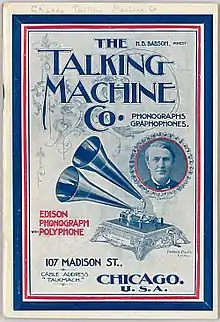Chicago Talking Machine Company
The Chicago Talking Machine Company (sometimes The Talking Machine Company of Chicago, or simply The Talking Machine Company) was a manufacturer and dealer of phonographs, phonograph accessories, and phonograph records from 1893 until 1906, and a major wholesaler of Victor Talking Machine Company products between 1906 and at least 1928.[1]

The company was founded in 1893 by Leon Douglass and Henry Babson, with financing from Charles Dickinson.[2][3] It first sold phonographs and supplies manufactured by the Edison Phonograph Works, but soon began manufacturing their own cylinder records and marketing a spring motor designed by Edward H. Amet.[4] After the collapse of the North American Phonograph Company in 1894, the company became a major independent distributor of phonograph records made by the Columbia Phonograph Company, the United States Phonograph Company, and Edison's National Phonograph Company, in addition to those of their own manufacture. Silas Leachman, a Chicago-based recording pioneer who specialized in coon songs, was their most popular artist.[5] By the first issue of the trade magazine Phonoscope in November 1896, the company was in a prominent enough position in the industry to buy the first full-page advertisement of the issue.[6]
In 1898, Leon Douglass, who had previously invented a coin-operation mechanism and phonograph record duplication process, invented the "Polyphone", which added a second horn and reproducer to the phonograph or graphophone to increase its loudness (and, supposedly, its fidelity). He formed The Polyphone Company at the same address as The Talking Machine Company (having dropped the "Chicago" prefix) to market the device[7] and would focus on this aspect of the business until joining Eldridge Johnson in 1900 to begin working on what would become the Victor Talking Machine Company.[8]
From 1903 until 1905, Henry Babson would manage the operation with his brothers Fred and Gus, and develop a mail-order operation and a national distribution network.[3] In 1906, the company was purchased by Arthur D. Geissler, son of the general manager of the Victor Talking Machine Company and reconfigured to wholesale Victor products, while the Babson Brothers formed a new company to sell and distribute Edison products.[9][10]
References
- "Chicago T.M. Co. in New Home". Talking Machine World. 24 (4): 94. April 1927. Retrieved 15 August 2017.
- Vander Lugt, Mason. "The Independent Record Companies of the 1890s". ARSC Blog.
- "Evolution of a Great Business". Talking Machine World. 6 (2): 42–43. February 1910. Retrieved 15 August 2017.
- Fabrizio, Timothy C.; Paul, George F. (2005). The Talking Machine: An Illustrated Compendium. Atglen, PA: Schiffer. p. 33. ISBN 0-7643-2240-0.
- The Talking Machine Co., Phonographs [and] Graphophones (1899 Catalog). The Talking Machine Co. 1899.
- "The Chicago Talking Machine Co. (advertisement)". The Phonoscope. 1 (1): 2. November 1896.
- "New Corporations". The Phonoscope. 2 (10): 11. October 1898.
- Gracyk, Tim. "Leon F. Douglass: Inventor and Victor's First Vice-President". Tim's Phonographs and Old Records. Retrieved 2017-08-15.
- "Talking Machine News from the West". Talking Machine World. 2 (2): 5. February 1906.
- Hoffman, Frank (2005). Encyclopedia of Recorded Sound. New York: Routledge. p. 184. ISBN 9780415938358.